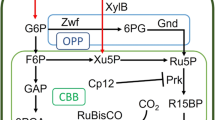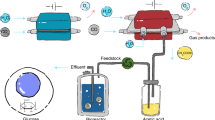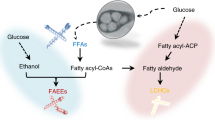Abstract
Biofuels are currently produced from carbohydrates and lipids in feedstock. Proteins, in contrast, have not been used to synthesize fuels because of the difficulties of deaminating protein hydrolysates. Here we apply metabolic engineering to generate Escherichia coli that can deaminate protein hydrolysates, enabling the cells to convert proteins to C4 and C5 alcohols at 56% of the theoretical yield. We accomplish this by introducing three exogenous transamination and deamination cycles, which provide an irreversible metabolic force that drives deamination reactions to completion. We show that Saccharomyces cerevisiae, E. coli, Bacillus subtilis and microalgae can be used as protein sources, producing up to 4,035 mg/l of alcohols from biomass containing ∼22 g/l of amino acids. These results show the feasibility of using proteins for biorefineries, for which high-protein microalgae could be used as a feedstock with a possibility of maximizing algal growth1 and total CO2 fixation.
This is a preview of subscription content, access via your institution
Access options
Subscribe to this journal
Receive 12 print issues and online access
$209.00 per year
only $17.42 per issue
Buy this article
- Purchase on Springer Link
- Instant access to full article PDF
Prices may be subject to local taxes which are calculated during checkout



Similar content being viewed by others
References
Sheehan, J., Dunahay, T., Benemann, J. & Roessler, P. A Look Back at the US Department of Energy's Aquatic Species Program: Biodiesel from Algae; Close-Out Report (National Renewable Energy Laboratory, Golden, CO, USA; 1998). <http://www.nrel.gov/biomass/pdfs/24190.pdf>
Wijffels, R.H. & Barbosa, M.J. An outlook on microalgal biofuels. Science 329, 796 (2010).
Miller, S.A. Minimizing land use and nitrogen intensity of bioenergy. Environ. Sci. Technol., 44, 3932–3939 (2010).
Melillo, J.M. et al. Indirect emissions from biofuels: how important? Science 326, 1397–1399 (2009).
Crutzen, P.J., Mosier, A.R., Smith, K.A. & Winiwarter, W. N2O release from agro-biofuel production negates global warming reduction by replacing fossil fuels. Atmos. Chem. Phys. 8, 389–395 (2008).
Erisman, J.W., Sutton, M.A., Galloway, J., Klimont, Z. & Winiwarter, W. How a century of ammonia synthesis changed the world. Nature Geoscience 1, 636–639 (2008).
Becker, E.W. Micro-algae as a source of protein. Biotechnol. Adv. 25, 207–210 (2007).
Hazelwood, L.A., Daran, J.M., van Maris, A.J.A., Pronk, J.T. & Dickinson, J.R. The Ehrlich pathway for fusel alcohol production: a century of research on Saccharomyces cerevisiae metabolism. Appl. Environ. Microbiol. 74, 2259–2266 (2008).
Atsumi, S., Hanai, T. & Liao, J.C. Non-fermentative pathways for synthesis of branched-chain higher alcohols as biofuels. Nature 451, 86–89 (2008).
Zhang, K., Sawaya, M.R., Eisenberg, D.S. & Liao, J.C. Expanding metabolism for biosynthesis of nonnatural alcohols. Proc. Natl. Acad. Sci. USA 105, 20653–20658 (2008).
Steen, E.J. et al. Microbial production of fatty-acid-derived fuels and chemicals from plant biomass. Nature 463, 559–562 (2010).
Biebl, H., Menzel, K., Zeng, A.P. & Deckwer, W.D. Microbial production of 1, 3-propanediol. Appl. Microbiol. Biotechnol. 52, 289–297 (1999).
Ingram, L.O., Conway, T., Clark, D.P., Sewell, G.W. & Preston, J.F. Genetic engineering of ethanol production in Escherichia coli. Appl. Environ. Microbiol. 53, 2420–2425 (1987).
Pruss, B.M., Nelms, J.M., Park, C. & Wolfe, A.J. Mutations in NADH: ubiquinone oxidoreductase of Escherichia coli affect growth on mixed amino acids. J. Bacteriol. 176, 2143–2150 (1994).
Connor, M.R., Cann, A.F. & Liao, J.C. 3-Methyl-1-butanol production in Escherichia coli: random mutagenesis and two-phase fermentation. Appl. Microbiol. Biotechnol. 86, 1155–1164 (2010).
Cann, A.F. & Liao, J.C. Pentanol isomer synthesis in engineered microorganisms. Appl. Microbiol. Biotechnol. 85, 893–899 (2010).
Xavier, K.B. & Bassler, B.L. Regulation of uptake and processing of the quorum-sensing autoinducer AI-2 in Escherichia coli. J. Bacteriol. 187, 238–248 (2005).
DeLisa, M.P., Valdes, J.J. & Bentley, W.E. Mapping stress-induced changes in autoinducer AI-2 production in chemostat-cultivated Escherichia coli K-12. J. Bacteriol. 183, 2918–2928 (2001).
Wang, L., Hashimoto, Y., Tsao, C.Y., Valdes, J.J. & Bentley, W.E. Cyclic AMP (cAMP) and cAMP receptor protein influence both synthesis and uptake of extracellular autoinducer 2 in Escherichia coli. J. Bacteriol. 187, 2066–2076 (2005).
Neidhart, F.C. Escherichia coli and Salmonella (American Society for Microbiology, 1996).
Atkinson, M.R., Blauwkamp, T.A., Bondarenko, V., Studitsky, V. & Ninfa, A.J. Activation of the glnA, glnK, and nac promoters as Escherichia coli undergoes the transition from nitrogen excess growth to nitrogen starvation. J. Bacteriol. 184, 5358–5363 (2002).
Reitzer, L. Nitrogen assimilation and global regulation in Escherichia coli. Annu. Rev. Microbiol. 57, 155–176 (2003).
Atsumi, S. Wu. T.-Y., Eckl, E.-M., Hawkins, S.D., Buelter, T. & Liao, J.C. Engineering the isobutanol biosynthetic pathway in Escherichia coli by comparison of three aldehyde reductase/alcohol dehydrogenase genes. Appl. Genet. Mol. Biotechnol. 85, 651–657 (2010).
Werpy, T. & Petersen, G., eds. Top Value Added Chemicals From Biomass, vol. I (Pacific Northwest National Laboratory, National Renewable Energy Laboratory and Office of Biomass Program for the Office of the Biomass Program of US Department of Energy, 2004). <www1.eere.energy.gov/biomass/pdfs/35523.pdf>
Wan, M.Y., Wang, H.Y., Zhang, Y.Z. & Feng, H. Substrate specificity and thermostability of the dehairing alkaline protease from Bacillus pumilus. Appl. Biochem. Biotechnol. 159, 394–403 (2009).
Baba, T. et al. Construction of Escherichia coli K-12 in-frame, single-gene knockout mutants: the Keio collection. Mol. Syst. Biol. 2, 2006.0008 (2006).
BD Biosciences. BD Bionutrients Technical Manual: Advanced Bioprocessing (Becton, Dickinson & Co., 2006). <http://www.bd.com/ds/technicalCenter/misc/br_3_2547.pdf>
Ohshima, T. et al. The purification, characterization, cloning and sequencing of the gene for a halostable and thermostable leucine dehydrogenase from Thermoactinomyces intermedius. Eur. J. Biochem. 222, 305–312 (1994).
Atsumi, S., Higashide, W. & Liao, J.C. Direct photosynthetic recycling of carbon dioxide to isobutyraldehyde. Nat. Biotechnol. 27, 1177–1180 (2009).
Smith, K.M., Cho, K.M. & Liao, J.C. Engineering Corynebacterium glutamicum for isobutanol production. Appl. Genet. Mol. Biotechnol. 87, 1045–1055 (2010).
Acknowledgements
This work was partially supported by UCLA–Department of Energy Institute for Genomics and Proteomics.
Author information
Authors and Affiliations
Contributions
Y.-X.H. designed and performed experiments, designed the theoretical calculation, analyzed data and wrote the manuscript; K.M.C. designed and performed experiments and analyzed data; J.G.L.R. designed and performed theoretical calculation; E.M. performed part of the experiments in Table 1; C.R.S. performed the chemical mutagenesis; Y.Y. designed and performed carbon-flux driven biofuel production; J.C.L. designed experiments, theoretical calculation, analyzed data and wrote the manuscript.
Corresponding author
Ethics declarations
Competing interests
J.C.L. is a cofounder of Easel Biotechnoloiges, which licensed this technology from the University of California, Los Angeles.
Supplementary information
Supplementary Text and Figures
Supplementary Tables 1–7 and Supplementary Figs. 1–11 (PDF 2087 kb)
Rights and permissions
About this article
Cite this article
Huo, YX., Cho, K., Rivera, J. et al. Conversion of proteins into biofuels by engineering nitrogen flux. Nat Biotechnol 29, 346–351 (2011). https://doi.org/10.1038/nbt.1789
Received:
Accepted:
Published:
Issue Date:
DOI: https://doi.org/10.1038/nbt.1789
This article is cited by
-
Biosynthesis pathways of expanding carbon chains for producing advanced biofuels
Biotechnology for Biofuels and Bioproducts (2023)
-
Evaluation of near-ambient algal biomass fractionation conditions for bioproduct development
Biomass Conversion and Biorefinery (2023)
-
Toward bioproduction of oxo chemicals from C1 feedstocks using isobutyraldehyde as an example
Biotechnology for Biofuels and Bioproducts (2022)
-
Techno-economic assessment for the production of algal fuels and value-added products: opportunities for high-protein microalgae conversion
Biotechnology for Biofuels and Bioproducts (2022)
-
Genetic and metabolic engineering for poly-γ-glutamic acid production: current progress, challenges, and prospects
World Journal of Microbiology and Biotechnology (2022)



